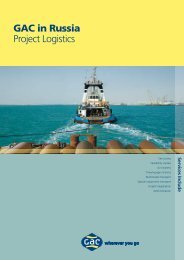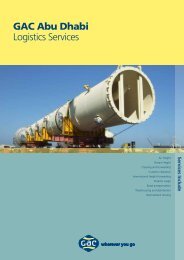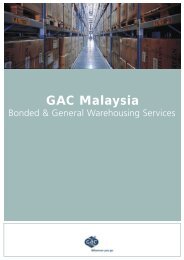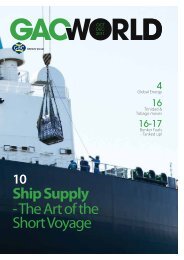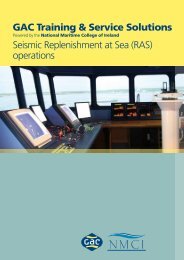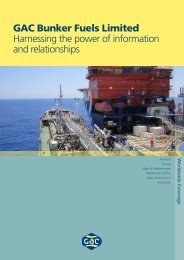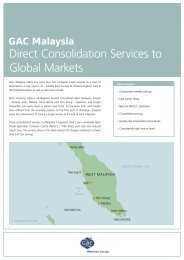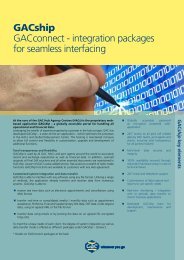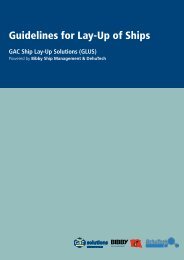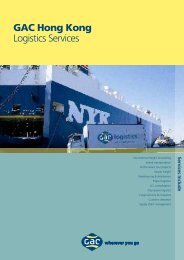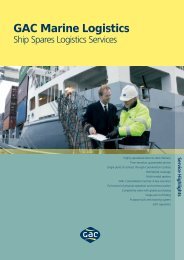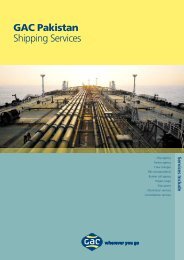New Look - GAC
New Look - GAC
New Look - GAC
- No tags were found...
You also want an ePaper? Increase the reach of your titles
YUMPU automatically turns print PDFs into web optimized ePapers that Google loves.
page 8BunkersBunkerManBunkers are booming. The International Bunker Industry Association says the amount of bunker fuels suppliedglobally has risen from 200 million tons in 2001 to 300 million tons in 2007 (including supplies to the inlandmarket).But it’s a volatile market, driven by factors such as politics or even the weather. With new challenges likeglobal warming emerging, things are not getting any simpler.Paul Horan, <strong>GAC</strong> Bunker Fuel’s London-based Director, knows intimately the challenges he and his globalteam face to stay on top in this business. He entered the oil industry in the late 1980s in his native Australia beforemoving to London to work as a bunker trader with Texaco Fuel and Marine Marketing (TFAMM). He joined <strong>GAC</strong>Bunker Fuels as Marketing Manager in 1997 and became Director in 2001.<strong>GAC</strong> World: Why are they calledbunker fuels?Paul Horan: It doesn’t have anything to dowith golfing hazards or bomb shelters, that’sfor sure!We use the term ‘bunker fuel’ todescribe any type of fuel oil used on ships. Abunker was the name given to the place usedfor storing coal on vessels in the days beforefuel oil tanks. The verb ‘bunker’, meaningsimply ‘to refuel’, is a relic from the dayswhen coal was king.GW: Who are the dominant players inthe global bunker supply businessand where does <strong>GAC</strong> fit in?PH: The global bunkers market can be dividedup, by market share, into four broad categories:• Major oil Companies, like Shell, ExxonMobil, Chevron and BP;• Mini Majors, such as state companies likeTotal or Gulf;• Independents;• Suppliers and Traders – this is the categorythat <strong>GAC</strong> BF falls into, though it couldbe argued that we also count as‘independents’ as we are not tied to anysingle supplier.GW: <strong>GAC</strong> has bunker operations inLondon, Cairo, Cape Town, the UAE,Singapore, Houston and Sri Lanka.Why choose those locations?PH: Our network reflects the major oil tradinghubs of London, Singapore, Dubai andSharjah in the UAE, and Houston. Singaporeis the world’s largest bunkering port, with arecord 30 million tons sold there this year.We added Cairo to that network inresponse to demand in the Suez Canal, to tiein with <strong>GAC</strong> Egypt’s key position servingvessels calling at Egyptian ports and transitingthrough the Canal.The addition of Sri Lanka was also astrategic move to arrange bunker supplieswith minimum deviation for vessels in oneof the world’s busiest shipping lanes, to thesouth of the island state.GW: What is the significance ofSharjah/Fujairah in the UAE?PH: <strong>GAC</strong> started its bunker operations inSharjah in the early 1980s. It was a convenientlocation, due to its proximity to the loadingarea off Fujairah which became a lifeline toGulf shipping during the early years of thedecade when Iran and Iraq were at war.GW: Why should a customer deal with<strong>GAC</strong> BF instead of cutting out themiddle man and going directly to aphysical bunker supplier?PH: In short, because we are entirelyindependent. <strong>GAC</strong> BF is a globalbroker/trader which acts in the best interestsof its clients for their bunker purchases.We have no hidden agenda on behalf ofany provider.From any one of our trading locations,we help our clients get their lubricants andfuels in the most competitive and timely way,worldwide. Our goal is to serve our clientswithout being beholden to any specificsupplier.That strength is further enhanced bythe fact that we are part of the <strong>GAC</strong> Groupand can connect customers with a wide rangeof services provided by the Group globally.GW: Bunkers seem to be a volatilemarket with prices shifting everyminute. What causes this volatilityand what do you do about it?PH: Yes, it sometimes seems like the beat ofa butterfly’s wing in China can send oil pricessoaring in the US.We all know – even if only from fillingup our car at the petrol station – that oilprices react to a dizzying number of variables,including the so-called PEST (Political,Economical, Sociological and Technological)factors. Instability in the Middle East? Pricesshoot up. Hurricanes ravaging the Caribbean?More increases. But there’s more to it thanthat - local conditions and availability alsofigure in the formula.As we actively trade bunkers on thespot market, we use our experience,judgement and knowledge of local conditionsto endeavour to buy at the best time (and
Bunkers page 9at the best price) on behalf of our clients.GW: What steps does <strong>GAC</strong> BunkerFuels take to ensure uniform servicestandards and effectivecommunication among staff fromdifferent cultures?PH: One of the strengths of the <strong>GAC</strong> globalorganisation is its diversity, evident in ourexpertise and experience of local marketconditions and practices. However, this istempered by standard procedures that ensureinternational standards are met.One of the ways we do this is throughour ISO 9001:2000 quality assurance, whichguarantees that standard procedures arealways followed. All products are purchasedin line with strict industry standards and weactively monitor suppliers’ performance.Another tool to ensure uniformity isthe use of our dedicated purchasing andtrading software, <strong>GAC</strong>OIL. This Internetbasedtrading platform was developedspecifically for us and is used to record alltransactions and suppliers’ performances. Itsbig advantage is that all our offices – nomatter where they are, or which time zonethey’re in – can see worldwide trading prices,availability and port restrictions in real time.GW: What qualities make a trulyexcellent bunker supply servicestand out from a standard run-of-themillservice?PH: What makes the difference is truly globalrepresentation, coupled with the ability toaccess additional services – perhaps to coincidewith bunker fuel delivery – to offer clients a‘holistic’ service package.This is where being part of the <strong>GAC</strong>Group really comes to the fore. Not only canwe arrange the bunker supplies, we can alsooffer an entire raft of ship agency and otherrelated services. And the beauty is that theywill appear on a single invoice!It’s that strong network of local officesthat makes <strong>GAC</strong> BF unique. We can providecustomers with reliable information aboutlocal port conditions and restrictions and it’sall part of the service – no hidden extras.No other bunker trader has their feetplanted so firmly on the ground, in so manylocations. We pride ourselves on being local,yet worldwide.GW: What are the major issues facingthe bunker fuels sector today? Andhow can they be addressed?PH: One of the most dramatic changes weare facing is the extension of the SulphurEmission Control Area from the Baltic Seato encompass the entire North Sea andEnglish Channel, which will significantlyincrease demand for 1.5% sulphur fuel oils.The challenge for the bunker industry is toengage with policy makers and legislators totackle global and regional pollution levels.Another major blip on the radar is continuing
page 10Bunkershigh crude oil prices. As a result, bunkerprices are reaching levels never before seenin the history of bunker trading. This putspressure on the credit lines of both tradersand suppliers, who become more vulnerableas they extend credit to accommodatecustomer demand.Another important issue is the changinginvestment climate. More and more investorsare attracted to port infrastructure and supplyoperations, areas not previously consideredworthy of attention. Also, the easing ofregulations in places with state-run operationslike Egypt and Iran is opening the doors forforeign investment in supply infrastructures.This will doubtless bring new competitionto the traditional mainstream bunker hubs.GW: What changes do you expect tosee in the next ten years?PH: Globalisation, spiralling demand fromnew industrial giants and a whole new mindsetwith regard to our responsibility to the planetrepresent the greatest challenges – andperhaps the biggest opportunities – that thesector has seen for decades.The coming decade will bring manyissues, but I am optimistic that in overcomingthem, the bunkers sector will emerge leaner,cleaner and in better shape.The European Union and theInternational Maritime Organisation areleading the way with new regulations toprotect the environment. Thanks to the riseof double-hull tankers (and the demise oftheir single-hull predecessors) and tightercontrols on fuel specifications to limitcarbon emissions, we can look forward tocleaner seas.Stricter fuel specifications should reducethe number of poor quality bunker deliveriesbeing made. <strong>New</strong> codes of practice shouldhelp eliminate cheating, and we are alreadyseeing far less tolerance when it is detected.There is also a sea change in the waybunker suppliers view the dangers inherentin shipping and strides are being made tovastly increase safety and security of shipsand their crews around the world.GW: So, what makes a bunkertrader happy?PH: What makes us happy? Well, top of thelist is beating the market and securing a pricefor our client that is below the listedPlatts publications. That’s guaranteed tobring a smile to the face of even the mostjaded trader.In <strong>GAC</strong> BF, we enjoy greater chancesof achieving a big smile because we often usetwo traders to close a deal. One of our officeswill receive the initial enquiry and then workhand-in-hand with the supply location officeto secure the best product price andavailability. When that all comes together,it’s a great feeling.Bunkerhighs & lowsBunker trader Mazen Abdel Hameed from <strong>GAC</strong> Bunker Fuels’ Egypt operationknows well the daily joys and sorrows of his business. Here is his shortlist of whatgets him high and what lays him low.Things that make me high1.2.3.4.5.6.7.When I win a business.When I add a new account to my company customers portfolio.When a new customer proves to be a good choice.Solving a last minute problem!Closing a claim without losing my customer or losing piece of my margin.Reaching & exceeding monthly target with my colleagues.A good "Thank you" from my customers, my colleagues, and my management.…and things that make me low1. Unexpected failure from other parties (Supplier/Customer) that ends withbusiness loss.2. Job Cancelled!3. Losing a claim and its consequences.4. Due to solving a crisis, a compulsory late staying in the office.
<strong>GAC</strong> Wrap page 11<strong>GAC</strong> sets up majorAustralianOperationNo worries mate - the team from downunder all present and correct.<strong>GAC</strong> has set up a network of 12 officesplus one HQ to serve the major portsof Australia.Changes in the port agency landscapeprompted <strong>GAC</strong> to set up a full, independentoperation there rather than form an alliancewith an existing partner.<strong>GAC</strong>’s previous alliance with OMS andbefore that with Adsteam had been successfulbut changes in majority ownership of parentcompanies had led to a rethink of how toposition <strong>GAC</strong> in Australia and the southPacific.“With 13 offices now active, <strong>GAC</strong>Australia has gone from nothing to becomeone of our bigger operations,” says ChristerSjödoff, <strong>GAC</strong>’s Asia-Pacific Regional Director.“We have recruited well and have puttogether an excellent team that willmaintain the business we already haveand win new business in this growingshipping market.”<strong>GAC</strong> Australia has its head officein Sydney under MD Phil Coolicanand National Operations ManagerScott Henderson.“Australia is both a major exporter andimporter,” says Christer. “We have some ofthe world’s biggest commodity cargoes leavingAustralian ports while imports ofmanufactured goods are growing strongly.”“We knew very clearly where to locateour operations offices,” says Lars Heisselberg,Vice President, Shipping Services. “We haveall the major capital city ports covered andhave also focused on the mining export portssuch as Port Hedland and Dampier for ironore on the West Coast and Mackay, Gladstoneand <strong>New</strong>castle for coal on the east coast.“As well, we have made sure we are allpresent and correct to serve the offshore oiland gas industry on the North West Shelf.Some of the biggest development andproduction projects in the world are takingplace in those waters.”The establishment of the Australianoperation has strengthened <strong>GAC</strong>’s presencein the Asia-Pacific region which nowstretches from the Koreas to the south islandof <strong>New</strong> Zealand and eastwards beyond Fijiand Tonga.An Easy CommuteSetting up a new operation headquartered in Sydney means Asia-PacificRegional Director, Christer Sjödoff, has to travel there regularly fromhis base in Singapore. And these days that means he gets to fly in theworld’s biggest commercial airliner, the Airbus A380.“It is even bigger than you expect it to be,” says Christer. “But theSingapore Airlines service is exactly what you expect it to be.”
page 12<strong>GAC</strong> Marine LogisticsShip sparesGetting down to detailsDuring the past sixmonths, GMLManaging DirectorChris Steibelt hasappointed new SalesManagers, a BusinessController and aB u s i n e s sDevelopmentManager to build onthe strong growth of his operation worldwideover the past four years. The new people (seeAppointments, page 18) - many of whomhave been recruited from within the <strong>GAC</strong>Group - are now in place in Asia, India,Europe and the Middle East. GML is alsocommissioning a new warehouse inRotterdam and plans are afoot to augmentthe customer service teams in Dubaiand Singapore.“These key personnel bring with themmany years of experience in our shippingand logistics business,” says Steibelt.“They understand the value we can offerthrough our unique door to deck spareslogistics concept.”It is certainly a concept whose timehas come.Imagine if you will…A ship owner has a problem. His vesselen-route to Brisbane has broken down.It needs a set of bespoke engine tools anda replacement pump.That means arranging for the spares tobe collected from the warehouse, packed,freighted, customs cleared, delivered directlyto the vessel, and to arrive in top operationalcondition.Any delay is costly. Yet traditionaldelivery methods are fragmented, involvemultiple parties, and cause coordinationchallenges, mishandling, miscommunicationand paperwork problems. These hiccupsoften break the supply chain, resulting inmoney lost. Giant headaches are made ofsuch glitches.What if…Now imagine the ship owner makes a singlecall to GML Asia's office based inSingapore. Once the call is done, GMLcolleagues around the world run the wholeshow - pick-ups from multiple supplierdoors, picking the best route, and thenfollowing the shipment through to thevessel’s deck.It’s seamless - one chain, one responsibleparty, one bill. Time saved, money saved,tempers saved. Job done, headachecured. That’s GML. (See articles page13 - 17)Four years on…It’s four years since <strong>GAC</strong> Marine Logisticsmade its debut. Now it provides servicesto over 400 vessels worldwide – fromtankers to cruise ships. GML now runsoffices in Dubai, Singapore, Mumbai,Rotterdam and Sao Paolo, and is supportedby warehouse consolidation centres atkey locations.“The ship spares business is all aboutmeticulous planning and time-definiteexecution,” says Steibelt. “These contactoffices in strategic locations keep uscloser to our customers and strengthencommunication links between all parties.”
<strong>GAC</strong> Marine Logistics page 13No Job TooBigfor GMLClose cooperation between <strong>GAC</strong> officesmade easy work of the delivery of four newboats from Turkey to Jordan. It was the firsttime <strong>GAC</strong> Marine Logistics (GML) hadcoordinated the movement of completevessels. Normally the market leader focuseson ship spares.Dock-to-dockUAE-based Lamnalco Group, a globalprovider of towage and marine services,appointed GML to manage the dock-to-dockmobilisation of the boats from the Tuzlashipyard in Turkey to Aqaba port in Jordan.With no suitable liner services plying theroute, GML chartered the ‘MV Glory’, avessel with the necessary heavy lift capabilityto load and discharge the cargo.Then GML called on <strong>GAC</strong> Turkey’sexpertise at origin, and <strong>GAC</strong> Jordan’s logisticsdepth at destination.It took two months of careful planning byGML to ensure seamless execution.From Maestro…At Tuzla, <strong>GAC</strong> Turkey acted as the ‘maestro’.It managed every detail of the operation fromarranging cradles for the boats to the delicateand time-sensitive loading and securingprocess. The careful planning reduced theloading and lashing to less than 2 hours andallowed an early departure.…To MaestroA week later, the ‘MV Glory’ arrived inAqaba. Here, <strong>GAC</strong> Jordan took over, handledthe unloading, customs formalities and finaldelivery to the client – on time and literally‘ship shape’.
page 14<strong>GAC</strong> Marine Logistics
<strong>GAC</strong> Marine Logistics page 15Airbornegiant bringsDoubleHappinessto SingaporeChinese people value highly the concept ofDouble Happiness. <strong>GAC</strong> Marine Logisticsmanaged to achieve it with one very bigaircraft.A GML client wanted a 25-tonne gasengine shipped from Wisconsin in the USAto Singapore in just 10 days.An ordinary commercial freight planecould not accommodate the height of theengine, so GML chartered an Antonov AN-124, until recently the world’s largest massproducedaircraft, to make the delivery. Butit came at a cost, so it was imperative thatnot a minute was wasted.Creative options“The AN-124 really was the only option forsuch a large cargo but it was pricey,” saysGML Asia Director Kenneth Bybjerg. “It wastime to get creative and think fast…“Another customer had a completelydismantled pedestal crane at Houston, alreadydelayed, and awaiting a break-bulk vessel toship it from Houston to Singapore. We offeredthe customer a discount airfreight solution(thus helping to offset the cost of hiring theAN-124). They confirmed instantly.“That meant a return to the drawingboard to work out a reduced rate for the firstcustomer, and examine the logistics optionsfor the overall operation. With our secondcustomer confirmed, we needed to get thefirst client on board too – as soon as possible.”Customer solutionsThe solution came with the offer of truckingthe engine and its accessories from Wisconsinto Houston, to join the second customer’scargo in the hold of the giant aircraft.Two days and two refuelling stops laterthe big bird reached Changi Airport.“Everything was delivered in time –the first customer avoided heavy day ratepenalties from their client, and the secondone went from being behind schedule tobeing back on track,” says Kenneth.“It was a giant-sized fairy tale – butwith two happy endings.”
page 16<strong>GAC</strong> Marine LogisticsMeeting a MalaysianOffshoreChallenge
<strong>GAC</strong> Marine Logistics page 17<strong>GAC</strong> provides offshore logistics and ship agency support for SBM’s KikehGAP Project. <strong>GAC</strong> Marine Logistics (GML) was awarded the logistics contractfor the GAP (Gravity Actuated Pipe) installation, which is part of Malaysia’s largestFloating Production Storage & Offloading (FPSO).Collaboration“From the moment we were awardedthe contract in February, to its successfulcompletion in August, we were workingunder tight and changing time schedules,”says Kenneth Bybjerg, Director of GML Asia.“It was a multi-faceted project thatoften required us to go beyond our jobscope and work in close collaborationwith the client, suppliers and portauthority to finish the task safely andon time.”Integrated servicesCollaboration on another level alsocontributed to the success of the project.Says Kenneth: “This was a greatexample of a client using a wide range of<strong>GAC</strong> services – not just warehousing andlogistics services, but also ship agencyand the supply of tugs and barges.”That collaboration was appreciated bythe client, according to SBM’s LogisticsManager, Virginie Gaudfrin-Serveille.She says: “We were most impressedby the structured and orderly way inwhich GML mobilized their resourcesand equipment, as well as their innovativesolutions to unexpected obstacles thatarose during the job.”Deep waterMoored at a depth of 1,320 metres about120 km north-west of Labuan Island,the FPSO Kikeh is a converted VLCCtanker of 280,000 dwt. It will store oilfrom Malaysia’s first deep-water discoveryand unload it to shuttle tankers everyten days.The Kikeh is owned and operatedby Malaysia Deepwater Terminal, a jointventure between MISC and SBM Offshore,a global supplier of facilities and servicesfor the development and productionof offshore oil and gas fields, as well asmooring systems.Unique challengesThe job presented the GML team with anumber of unique challenges, includingthe assembly of an 86-tonne marinebuoy – the first of its kind in the world.The task was something like a giantconstruction set with 20 modules, eachweighing more than 2 tonnes, built arounda central flange. Other tasks included:• bonded warehousing and inventorymanagement;• supply vessel and tug / barge chartering;trail fitting, cutting and welding ofanchor chains;• port agency services for chartered supplycraft, tug / barges and vessels comingfrom Europe with equipment;• equipment importing from variousEuropean origins, and exportingto Malaysia;• hazardous cargo handling; loading ofbarges including heavy lifts;• and demobilizing equipment once thejob was completed.Co-operationThe key to success was GML’s closecollaboration with all parties involved, saysKenneth.“Among others, we had to liaise withSBM, the manufacturers of the buoyand suppliers of heavy-lift equipment toconduct and present a risk assessment ofthe task to the Singapore Port Authority,”he says. “Due to the magnitude of thetask and the fact that it was the first ofits kind, a special permit had to beobtained. This was granted thanks to thecomprehensive risk evaluation report.”
page 18<strong>GAC</strong> WrapMoves &AppointmentsHSSECorner<strong>GAC</strong> HQ, Jebel AliDavid BerggrenAccountantPreviously:Accountant with KPMGNS<strong>GAC</strong> Abu DhabiJanaka GunawardenaBusiness Manager, LogisticsPreviously:General Manager with Al-HamdInternational Container Terminal(Pvt.) Ltd., PakistanShipping Marketing- Piraeus, GreeceNikos MarmatsourisSenior Marketing Manager,responsible for Albania, Algeria,Bulgaria, Cyprus, Egypt, Georgia,Hungary, Lebanon, Libya, Malta,Morocco, Romania, Russia(Black Sea), Syria, Tunisia, Turkeyand UkrainePreviously:Marketing ManagerMaria AngelidouMarketing Manager, responsiblefor GreecePreviously:Marketing Executive<strong>GAC</strong> DubaiPontus FredrikssonFinancial ManagerPreviously:Financial Manager for EF ILS BV<strong>GAC</strong> PakistanJohan JaningFinancial ManagerPreviously:Accountant at <strong>GAC</strong> HQ,Jebel Ali<strong>GAC</strong> Marine Logistics – GreeceHarris TheodarakisSales ManagerPreviously:Operations Executivewith <strong>GAC</strong> Egypt<strong>GAC</strong> Marine Logistics – Middle EastOshadha C WarnapuraSales Manager, Middle EastPreviously:More than 7 years experiencein the regional shipping andlogistics industryTwo years accident free:Maersk Oil Qatar has congratulated theMaster and crew of <strong>GAC</strong> Marine’s AnchorHandling Tug “Susanna” for two years constantoperation in the Al Shaheen Field with nowork days or time lost due to accidents.Safe working conditions are a primeconcern for Maersk Oil Qatar, hence itsrecognition of safety improvement orachievements by onboard personnel, like thecrew of “Susanna”.Klaus HolmagerInternational Moving ManagerPreviously:Moving Manager with CSSConsolidators Shipping ServicesRehan NaeemClearing & ForwardingOperations ManagerPreviously:Sales Executive with <strong>GAC</strong> Dubai<strong>GAC</strong> QatarDeri MorganOperations Manager,Contracts & Support ServicesPreviously:Contracts & MaintenanceManager for <strong>GAC</strong> QatarAsia Pacific RegionFredrik NystromBusiness Controller forAsia Pacific RegionPreviously:Financial Manager for<strong>GAC</strong> Pakistan<strong>GAC</strong> Marine Logistics - RotterdamDarren BallBusiness DevelopmentManager, LogisticsPreviously:<strong>GAC</strong> US Representative,Logistics Services<strong>GAC</strong> Saudi ArabiaAbdul Aziz HawajGeneral Manager, Shipping andOperations (based in Dammam)Previously:Assistant General Manager,Operations for <strong>GAC</strong> Saudi Arabia<strong>GAC</strong> Marine Logistics - AsiaSadan NairSales Manager, Hong KongPreviously:Business Manager for <strong>GAC</strong>Samudera Logistics, JakartaUlf OlaussonSales Manager, SingaporePreviously:Business Controller with<strong>GAC</strong> DubaiGood Truck, Bad Truck:Staff from <strong>GAC</strong> Qatar presented a displayhighlighting the differences between goodand bad trucking safety, as part of the QatarLiquefied Gas Company’s Health Safety andEnvironment Day. As the official logisticsprovider for the company’s 3 & 4 project,<strong>GAC</strong> Qatar was ideally placed to highlightthe importance of HSE issues in trucking.First Class First Aid:As part of <strong>GAC</strong> Dubai’s ongoing initiativeto ensure that as many employees as possibleare trained on First Aid and CPR skills, 30staff recently completed a course at a localhospital where they learned a series of simple,yet life saving techniques.
Insight page 19Cargo and Liability Insurance:Some peopledon’t get it‘Be Prepared’ says the Scout motto. ‘Be Protected’ says Jean Richmond,<strong>GAC</strong>’s Logistics Liability Insurance Administrator.Most people try to ignore insurance.They only warm to the subject whenthey have a claim and come face-tofacewith their policy’s fine print. That’sunderstandable as insurance can seem likean endless maze of fancy terminology andevasive conditions - not to mention thebewildering range of insurances available inthe market.Insurance is an unavoidable fact ofmodern life – from the car and householdcoverage many of us have, to specializedbusiness coverage for crops, disability,kidnapping, etc. And with international tradegrowing all the time, there are also logisticsliability insurance and cargo insurance.Liability or cargo cover?Many service providers and customers oftendon’t see the distinction between liabilityinsurance and cargo insurance. They also don’trealise just how imperative it is to have suchcover in place.All owners of cargo (or other cargointerests) should be insured against risks ofloss or damage, up to the full value of theirgoods, for the duration of the movement andincluding any temporary or longer termstorage. That is cargo insurance.Even if there is cargo insurance in force,the freight forwarder/transport operator needsto protect himself against claims of havingcaused or contributed to any loss or damage.This is liability insurance and all reputablelogistics and freight forwarding companieshave it.Relying on Peter to cover PaulOne thing that is not sustainable is for acustomer/cargo owner to rely on the liabilityinsurance of his logistic provider as a substitutefor having good cargo insurance. The liabilityof the logistics operator – and his liabilityinsurers – is normally subject to the monetarylimitations set out in his standard tradingconditions or in the transport conventionapproved by his insurers.<strong>GAC</strong> arranges comprehensive LiabilityInsurance with TT Club, one of the industry’sleading and most experienced insurers.Cargo owners without proper insurance arevulnerable to exposure for monetary losseswhich they will be unable to recover - eitherin full, or in part.<strong>GAC</strong>Sure: taking awaythe headacheAs part of <strong>GAC</strong>’s logistics solution, we providecomprehensive cargo insurance for customersthrough the <strong>GAC</strong>Sure concept.In a nutshell, <strong>GAC</strong>Sure takes away thecustomer headache of having to arrangeinsurance for themselves. Most local <strong>GAC</strong>offices around the world can arrange insuranceon their customers’ behalf. Then, in the eventof an incident, it’s the local <strong>GAC</strong> office thatinforms the insurers and assists the customerin handling the claims process until itsconclusion.Insurance premium costs are generallysmall when compared to the potential lossthat could be suffered by the cargo owner.So ask yourself…Are you adequately protected?-----Have you identified and understoodthe risks you will be assuming?Do you clearly understand the crucialconditions of your insurance cover?Do you know who to call to get clarificationon your cover?Are you accepting responsibility fortasks beyond your area of expertise or forwhich you are not covered?Do your logistics providers haveadequate liability insurance in place?Are you sleeping comfortably?If you follow the basic steps of protectingyour liability, there will be less to fear. Thesimple truth is that accidents do happen –especially in the frantic world of internationallogistics - but with the right insurancecoverage, you can sleep more comfortably inthe knowledge that your interests, and yourpockets, are protected.You don’t have to be a BoyScout to ‘Be Prepared’, but you dohave to be prepared to ‘Be Protected’.Some of the things that can go wrong...
page 20Wherever You Go<strong>GAC</strong>AngolaFor decades, the first thing that came to mind when people mentioned Angolawas bitter civil war. Today, ten years after the shooting stopped, it is one of thefastest-growing economies in Africa – and indeed the world.<strong>GAC</strong> was quick to spot the potential of thecountry’s offshore oil reserves and enteredthe Angolan market in 1998. Now <strong>GAC</strong>Angola is the undisputed market leader inthe country’s crude oil tanker business anda steadily increasing force in the dry cargosegment.The needs of this sector are metthrough a full range of shipping, logistics andmarine services provided from <strong>GAC</strong>’sheadquarters in the capital, Luanda, andbranches in Soyo, Cabinda and Lobito.Quick-marchGeneral Manager Joao Oliveira has aworkforce of 30 and ambitious expansionplans for the next five years.“With the civil war now in the past andvast oil reserves being discovered, Angola ison a quick-march towards development,”says Joao. “In addition to the oil sector,opportunities are opening up for logisticsservices as the government gradually restoresroad and rail networks that were destroyedor neglected during the war years.“These developments led us to openthe Lobito office. With the <strong>GAC</strong> brand nameand our quality service standards we hope tobecome a well-known name in Angola, notonly in the shipping sector but as a completeservice package provider.”
Wherever You Go page 21Offshore oil reserves are fuelling development to makeAngola one of the world’s fastest-growing economies.The <strong>GAC</strong> Luanda team are: (back row, left to right) Sabino Matias, Ivraldo Fonseca andMagnus Olson, and (front row, left to right) Jordao Alfredo Joaquim, Manuel Bartolomeu,Shipra Gulati, Jose Rafael, Diana Chimbayeka and Deckas Karimba.
page 22My TownAshgabatTurkmenistanBy Greg & Kylie Flintgregory.flint@gacworld.comCity characterAshgabat became the capital of the newlyindependent country of Turkmenistan on 27October 1991. Its former Soviet heritage isstill very much in evidence, from therampaging packs of Lada motorcars in thestreets to the widespread use of the Russianlanguage.During the past five years, it has becomea city of white with marble facades adorningall the buildings, many the result of anaggressive building campaign initiated byformer President Niyazov.Getting inGetting a visa still takes at least six weeks –no exceptions – and many questions from aswarm of uniforms checking your paperswhen you arrive at Ashgabat Airport.Where to stayStrict immigration rules mean that visitorsare restricted to a few hotels. Among theseis ‘The Nissa’, which caters to European andRussian business travellers.Greg & Kylie in front ofAshgabat's Monument to NeutralityWe thought we’d seen it all - from commercial fishing in the Pacific and IndianOceans to handling insurance accounts in the mountains of Papua <strong>New</strong> Guinea.But when we learned that Greg was being sent to Turkmenistan to manage <strong>GAC</strong>Marine’s operation there, we had to reach for the atlas.Once we’d found Turkmenistan, like the adventurous Australians we are, we thought“Why not?” Just over a year later, we have settled in Ashgabat - and it’s been quitean experience.Home, sweet homeWe have a villa in the city centre, withinwalking distance of the main Russki Bazaar.The furniture is an eclectic mix of traditionalTurkmen carpets and western furnishings,not forgetting the obligatory evil eye hangingabove the door to keep us safe.Eating outAshgabat has a number of restaurants, smallcafes and beer gardens. The fare has a veryRussian flavour and seems to be dominatedby cucumbers and tomatoes (with endlessvariations on the theme). ‘Shashlik’, a typeof kebab cooked on special barbeques calledmangals, forms the basis of many meat derivedmeals. Pizzas, heavy on the cheese, are widelyavailable and very popular, but the likes ofKFC and McDonald’s haven’t made it toAshgabat yet.
My Town page 23Drinking outBeer is widely available and vodka iscompulsory! All functions and parties involveendless toasts and sobriety is not encouraged.There are several beer gardens near our houseand entertainment ranges from a man playinga saxophone to blasting Russian rock music.Our particular favourite has a karaokemachine with many locals giving it their allin (for want of a better word) enthusiasticperformances.ShoppingMost shopping is done in one of the city’sfive bazaars, each of which specializes insomething. Refrigeration is not commonlyavailable, so weekly meat shopping happenswhen the butcher brings fresh meat to town.Fruit and vegetables are generally of goodquality. The town’s one supermarket stocksmostly imported goods from Turkey andoccasionally the Emirates.Sights to seeHead for the Health Park to see competingTurkmen wedding parties clash. In hertraditional attire, the bride is burdened by40 kg of jewelry and surrounded by guestsdancing to a three-piece band as they walkaround the park, culminating in the releaseof some doves and the opening of thechampagne.A new and very popular attraction isThe Land of Turkmen Fairy Tales (roughtranslation), known to all as TurkmenDisneyland. Many of its rides wouldn’t beout of place in any international amusementpark, but here the whole family joins in thefun - including Babushka (Grandma), holdingon grimly as she rides the rollercoaster.On a more historical note, Turkmenistanlies on the Old Silk Road and there are manyarcheological sites less than an hour’s drivefrom Ashgabat. One is the Parthian site of‘Old Nisa’, which was either a royal residenceor temple complex that was abandonedbetween 250BC and 226AD.What’s goodWalking through Tolkuchka Bazaar on aSunday morning; everything from camels tocars, carpets, imported Chinese and Iraniangoods and traditional jewelry is sold.The people – though English is not commonlyspoken there is always a connection betweenyour neighbours, the owner of the small caféyou go to and especially your butcher.…and not so goodThe summer - you need to be very carefulwith food as some handling practices are notwhat you might expect.Carpets at the bazaarThe 2300-to-0600 curfew, which varies inits degree of enforcement, and the constantsecurity presence on every street corner.And the driving! People drive likethey’re riding horses in a desert race and jostlefor position at every opportunity – even ifit’s only 10cm.Kylie’s highlightsFinding a butcher I can trust (with the helpof a local friend), then learning how torecognise cuts of meat not wrapped in plasticon Styrofoam trays, whilst laughing off theflirtations of the butcher.The Kopet Dag Mountains are beautifulall year round, but especially in the springwhen they’re covered with red poppies andpicnickers.a Turkmen weddingRusski bazaarThe friendliness of the local people and theirgenuine interest in my well-being.Greg’s highlightsOur office is next door to the compoundwhere foreign dignitaries are accommodated.In the past few months, the Presidents ofIran, Afghanistan and Russia have all stayedthere. The security presence is enormous andwe are literally locked in for hours as theVIPs come and go.Unfortunately, there is no prior warningwhen this happens. So, when the securityforces are posted at our gates, we have toclimb over the back fence to go home- not a good look when wearing asuit and carrying a laptop.
page 24<strong>GAC</strong> Wrap<strong>GAC</strong> signs withManchester UnitedManchester United Soccer Schools’ coaches welcome the <strong>GAC</strong> logo to the teamManchester United has signed a new player. But rather than being a renownedballplayer, the newcomer’s skills have a distinct logistics touch. The football clubhas appointed <strong>GAC</strong> Logistics as the official logistics supplier for ManchesterUnited Soccer Schools (MUSS) programmes and events around the world.MUSS coaching clinics in the UK,Hong Kong, Dubai and US draw thousandsof young players each year, all aspiring to‘Learn to play the United Way’.<strong>GAC</strong> recently completed the firstshipments under the new agreement,moving training kits and equipmentto destinations in Sweden, the USand Macau for a series of summercoaching clinics.Bill Hill, Group Vice President, LogisticsServices, says: "Managing the logisticsfor Manchester United Soccer Schools -the world’s biggest sporting club - goesbeyond moving products from A to B.It gives us the opportunity to playour part in the development of sporteducation.”Manchester United Soccer SchoolsDirector, Emma Savage, says the partnershipwith <strong>GAC</strong> has started on a very positivenote with the smooth handling of sometime-sensitive shipments.“We have been very impressed withthe way the team at <strong>GAC</strong> Manchesterdeveloped the most expedient and costefficient way for each delivery,” she adds.“The MUSS programmes attract globalinterest and we are constantly lookingfor partners that can support ourinternational expansion objectives.With the <strong>GAC</strong> partnership in place,we can now work with their internationallogistics network to help fulfil theseambitions.”www.gacworld.com



